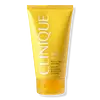What's inside
What's inside
 Key Ingredients
Key Ingredients

 Benefits
Benefits

 Concerns
Concerns

 Ingredients Side-by-side
Ingredients Side-by-side

Water
Skin ConditioningIsopropyl Palmitate
EmollientGlycerin
HumectantAlcohol Denat.
AntimicrobialButyrospermum Parkii Butter
Skin ConditioningAloe Barbadensis Leaf Juice Powder
Skin ConditioningSodium Hyaluronate
HumectantDimethicone
EmollientPolyglyceryl-10 Stearate
Skin ConditioningAcrylates/C10-30 Alkyl Acrylate Crosspolymer
Emulsion StabilisingSodium Hydroxide
BufferingEthylhexylglycerin
Skin ConditioningPhenoxyethanol
PreservativeLinalool
PerfumingCitral
PerfumingParfum
MaskingWater, Isopropyl Palmitate, Glycerin, Alcohol Denat., Butyrospermum Parkii Butter, Aloe Barbadensis Leaf Juice Powder, Sodium Hyaluronate, Dimethicone, Polyglyceryl-10 Stearate, Acrylates/C10-30 Alkyl Acrylate Crosspolymer, Sodium Hydroxide, Ethylhexylglycerin, Phenoxyethanol, Linalool, Citral, Parfum
Water
Skin ConditioningAloe Barbadensis Leaf Juice
Skin ConditioningButylene Glycol
HumectantHydrogenated Polyisobutene
EmollientPEG-8
HumectantPentaerythrityl Tetraethylhexanoate
EmollientCaprylic/Capric/Myristic/Stearic Triglyceride
EmollientGlyceryl Stearate
EmollientPEG-100 Stearate
Triticum Vulgare Germ Extract
Skin ConditioningHordeum Vulgare Extract
EmollientPerilla Ocymoides Leaf Extract
TonicStearic Acid
CleansingTribehenin
EmollientMicrococcus Lysate
Skin ConditioningChamomilla Recutita Extract
Skin ConditioningCholesterol
EmollientIsostearic Acid
CleansingCetearyl Alcohol
EmollientLecithin
EmollientTocopheryl Acetate
AntioxidantBis-Diglyceryl Polyacyladipate-2
EmollientSucrose
HumectantPolysorbate 60
EmulsifyingTromethamine
BufferingDimethicone
EmollientCaprylyl Glycol
EmollientSodium Hyaluronate
HumectantLinoleic Acid
CleansingSqualane
EmollientStearyl Alcohol
EmollientSodium Beta-Sitosteryl Sulfate
Skin ConditioningMagnesium Ascorbyl Phosphate
AntioxidantHexylene Glycol
EmulsifyingCarbomer
Emulsion StabilisingDisodium EDTA
Phenoxyethanol
PreservativeCI 42090
Cosmetic ColorantCI 19140
Cosmetic ColorantCI 61570
Cosmetic ColorantWater, Aloe Barbadensis Leaf Juice, Butylene Glycol, Hydrogenated Polyisobutene, PEG-8, Pentaerythrityl Tetraethylhexanoate, Caprylic/Capric/Myristic/Stearic Triglyceride, Glyceryl Stearate, PEG-100 Stearate, Triticum Vulgare Germ Extract, Hordeum Vulgare Extract, Perilla Ocymoides Leaf Extract, Stearic Acid, Tribehenin, Micrococcus Lysate, Chamomilla Recutita Extract, Cholesterol, Isostearic Acid, Cetearyl Alcohol, Lecithin, Tocopheryl Acetate, Bis-Diglyceryl Polyacyladipate-2, Sucrose, Polysorbate 60, Tromethamine, Dimethicone, Caprylyl Glycol, Sodium Hyaluronate, Linoleic Acid, Squalane, Stearyl Alcohol, Sodium Beta-Sitosteryl Sulfate, Magnesium Ascorbyl Phosphate, Hexylene Glycol, Carbomer, Disodium EDTA, Phenoxyethanol, CI 42090, CI 19140, CI 61570
Ingredients Explained
These ingredients are found in both products.
Ingredients higher up in an ingredient list are typically present in a larger amount.
Dimethicone is a type of synthetic silicone created from natural materials such as quartz.
What it does:
Dimethicone comes in different viscosities:
Depending on the viscosity, dimethicone has different properties.
Ingredients lists don't always show which type is used, so we recommend reaching out to the brand if you have questions about the viscosity.
This ingredient is unlikely to cause irritation because it does not get absorbed into skin. However, people with silicone allergies should be careful about using this ingredient.
Note: Dimethicone may contribute to pilling. This is because it is not oil or water soluble, so pilling may occur when layered with products. When mixed with heavy oils in a formula, the outcome is also quite greasy.
Learn more about DimethiconePhenoxyethanol is a preservative that has germicide, antimicrobial, and aromatic properties. Studies show that phenoxyethanol can prevent microbial growth. By itself, it has a scent that is similar to that of a rose.
It's often used in formulations along with Caprylyl Glycol to preserve the shelf life of products.
Sodium Hyaluronate is hyaluronic acid's salt form. It is commonly derived from the sodium salt of hyaluronic acid.
Like hyaluronic acid, it is great at holding water and acts as a humectant. This makes it a great skin hydrating ingredient.
Sodium Hyaluronate is naturally occurring in our bodies and is mostly found in eye fluid and joints.
These are some other common types of Hyaluronic Acid:
Learn more about Sodium HyaluronateWater. It's the most common cosmetic ingredient of all. You'll usually see it at the top of ingredient lists, meaning that it makes up the largest part of the product.
So why is it so popular? Water most often acts as a solvent - this means that it helps dissolve other ingredients into the formulation.
You'll also recognize water as that liquid we all need to stay alive. If you see this, drink a glass of water. Stay hydrated!
Learn more about Water